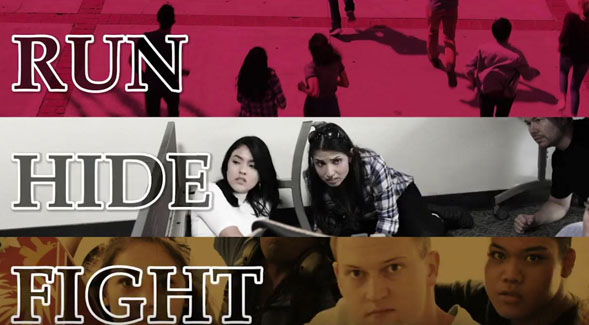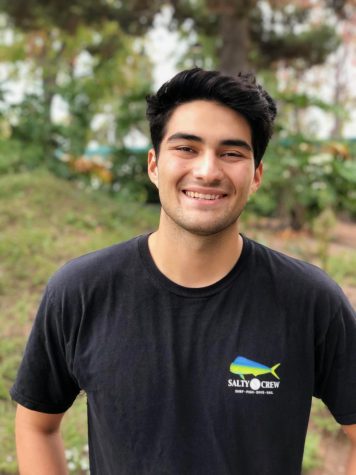Junior Evan Conway studies history at San Diego State. But prior to college, his life was almost cut short by an active shooter.
Conway was living in the Bay Area a few years ago when an active shooter situation threatened his local high school.
The shooter’s motive, a recent breakup, led the student to walk onto Homestead High School with a loaded gun. This was all it took for Conway and many other teenagers to barricade the entire second floor before police officers responded.
This ongoing phenomenon has affected communities across California — from shootings at a Poway synagogue to Saugus High School in Santa Clarita. The casualties range from just a few injured to countless lives taken.
And like schools across the country, SDSU is no stranger to gun violence.
A campus shooting in 1996 left three professors dead, and many spaces around campus have remained the same infrastructurally since then, making them vulnerable to a future potential aggressor. For many newer buildings, this is less so the case. And broad range of construction dates for buildings throughout campus means the doors are different in Hepner Hall, Storm Hall, and Adams Humanities, to name a few. These doors would be the first line of defense in an active shooter scenario, making them an important safety consideration.
SDSU is a large public space, but there is no way to lock some of these doors in the event of an active shooter — a critical safety concern.
The grim realization that there is no way to lock many campus doors is pronounced in the remedies provided in the university’s active shooter training, which focus on the run, hide and fight model.
Active shooter response training and the concerns
SDSU Police has held active shooter response training for 11 years, campus police Corporal Mark Peterson said. Since formulated in 2008, he said the training has evolved after studying student input as well as outcomes in recent tragedies, such as the shooting at Marjory Stoneman Douglas High School in Parkland, Florida.
Peterson said some students have improvised barricades by moving a table on its side, so it is wider than the door, then looping a belt between the table and door handle to prevent it from opening.
“There is no set standard for every set door on campus,” Peterson said. “Every door is different. Not every door has the closing hinge on it, so you may have to think of something creative.”
Many classrooms have doors that would fall into this category, but others also have tables and chairs bolted into the ground, making doors nearly impossible to barricade with furniture.
Jayla Lee, a research professor in the Journalism and Media Studies department, said she had concerns over the enforcement of the active shooter response training as well as the inability to lock her classroom doors.
“As an instructor myself, that is an unsettling feeling that the only thing I can rely on to close up my classroom is our supplies,” Lee said. “In both of my classrooms the desks are bolted to the ground so it would be difficult to find something to block the door completely.”
She said her concerns over the health of her students has increased since seeing news of repeated lockdowns at colleges around California, including CSU Los Angeles and CSU Long Beach.
On Oct. 7, a threat of a gunman on the Long Beach campus prompted a lockdown until one suspect was arrested.
Although no one was hurt, the panic and lockdown in classrooms brought up an important issue: none of the classrooms mentioned could be locked. In a stream of tweets, many students complained they had to stack chairs as tall as the doors to barricade the entrances.
Lee said people working at the active shooter training told her obtaining a key would be impossible at the moment but it may be discussed in the future.
“I would love to have access to keys to my classroom, but unfortunately that is not the case right now,” Lee said. “I would like to think that students on this campus are prepared, but with recent news at other CSU’s, I’m not sure that’s the case.”
Why can’t teachers lock their doors?
In a statement from the university facilities department — which oversees access control — all buildings have exterior doors that can be locked, but due to fire safety standards, most interior classrooms cannot be locked, even in the event of an emergency. This prevents teachers from securing their doors if there is no barricade available.
“Not every space is secure enough to lock yourself in,” Peterson said. “If it is not suitable, we would recommend going to another space that is more suitable. It’s not an easy thing to talk about, but we try to make it palatable for most people to be there and be engaged and actively think about the situation.”
Facilities said in the statement that they are working toward a more uniform exterior lock system on buildings. But there is no lock system yet in place for interior doors. Until an improved and uniform approach to exterior locks is implemented, the complexity of shutting down all buildings on campus remains an imperative concern.
Increasing active shooter response training attendance
Others like Lee say the fact active shooter response training sessions are optional leaves many SDSU community members uninformed.
“I personally believe that everyone on campus should be required to take an active shooter training,” Lee said.Even though it is not required, Peterson said certain departments recommend their staff go through the training. But as of now, university officials have not commented on whether making these sessions a campus-wide requirement would be feasible.
“That’s not something that is in the hands of the police department,” Peterson said.
While campus police did not have any statistics available regarding the active shooter prevention training participation rate, Peterson said increasing access was a key priority.
“I would like everyone who wants to be in a training to have access to it,” he said.
Political science senior Ricardo Castro said he did not know the university offered active shooter trainings.
“I feel safe around campus, even though it is a public space,” he said. “I grew up in El Centro, and (I) don’t hear nearly as much (about) crimes now that I live here.”
Castro said he would still be reluctant to attend an active shooter training if it were more heavily enforced around campus.
“It takes time to learn the skills, and I think offering them as one-unit courses would encourage students to take it,” he said.
There may never be a catch-all answer to stopping gun violence in public educational spaces, but there are many early preventative measures to consider in boosting shooter prevention training attendance and infrastructural safety.
Conway now spends his days working for Associated Students under the housing department and helps university police execute the active shooter response training.
Conway said through his work, and in participating in the active shooter response training, the university has taken appropriate measures to address tragedies from across the state and country and turn lessons into preparation. He also said finding a way to secure doors quickly would solve a lot of student and faculty concerns.
“You need to tell yourself that at the end of every day, you will make it home safe. That is how you get yourself out of every situation,” Conway said. “In regard to the safety of students, there needs to be a way of locking the door. I’m sure there is something we can use to lock doors without giving teachers a key to every single room.”
Lee said the university has a lot of space to improve the program going forward.
“We are about education at the university and promote preparation,” Lee said. “I would rather be prepared in that approach than wait for an issue and have to deal with it later.
“I think this is a great time to learn from the other CSU’s and not end up as the next trend on Twitter,” she said.
A previous version of this story featured quotes from campus police officials where they had provided us with inaccurate information. These lines have since been corrected. The Daily Aztec regrets this error.









